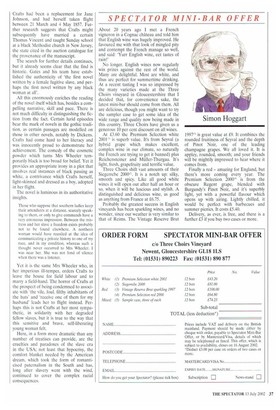The first in line
Ronald Segal
THE BONDWOMAN'S NARRATIVE by Hannah Crafts
Virago, £10.99, pp. 338, ISBN 1860490131
Henry Louis Gates Jr. chairs the Department of Afro-American Studies at Harvard University and has written, among other notable works, a classic of literary criticism in The Signifying Monkey. In February 2001, he bought, at an auction in New York, a manuscript described in the catalogue as 'a fictionalised biography, written in an effusive style, purporting to be the story, of the early life and escape of one Hannah Crafts, a mulatto, born in Virginia'. The low price he paid reflected the risk that the work was of incompatibly recent production or a form of 'literary racial ventriloquism' for which there exist, though rare, various 19th-century examples.
The Bondwoman 's Narrative is two books for the price of one, each of them the more captivating for the other. The first is an extensive introduction, in which Gates describes how, with the help of specialist researchers, he established the authenticity of the manuscript. The type of ink and paper employed, certain references in the text and the absence of any to secession or the civil war led an expert to conclude that the manuscript dated from the period 1853-61. The writer had used a thimble to make 'moistened paste wafers' bond more strongly to the page in revising the text. This made it highly probable that the writer was a woman. But was she black?
Stylistic and narrative details provided persuasive evidence that she was. But the most exciting find came in the search for other identities. Slave narrators generally confirmed the truth of their accounts by giving the real names of the people involved. Gates accordingly directed research to the census and other records of the period for any correspondence with the names of characters in the novel. He struck the mother-lode in John Hill Wheeler, an ardent advocate of slavery, who mounted one of the earliest legal challenges for the return of a runaway, Jane Johnson, under the Fugitive Slave Act of 1850. Entries in Wheeler's diary, together with references to the Wheeler household in the Crafts manuscript, make it all but certain that Crafts had been a replacement for Jane Johnson, and had herself taken flight between 21 March and 4 May 1857. Further research suggests that Crafts might subsequently have married a certain Thomas Vincent and taught Sunday school at a black Methodist church in New Jersey, the state cited in the auction catalogue for the provenance of the manuscript.
The search for further details continues, but it already seems clear that the find is historic. Gates and his team have established the authenticity of 'the first novel written by a female fugitive slave, and perhaps the first novel written by any black woman at all'.
All this enormously enriches the reading of the novel itself which has, besides a compelling narrative, skill and pace. There is not much difficulty in distinguishing the fiction from the fact. Certain lurid episodes bear the mark of novels in the gothic tradition, as certain passages are modelled on those in other novels, notably by Dickens. Crafts had come hard to her literacy and was innocently proud to demonstrate her achievement. The comedy of the cosmetic powder which turns Mrs Wheeler temporarily black is too broad for belief. Yet it provides an appropriate irony in a plot that involves real instances of black passing as white, a contrivance which Crafts herself, light-skinned and dressed as a boy, adopted in her flight.
The novel is luminous in its authoritative insights.
Those who suppose that southern ladies keep their attendants at a distance, scarcely speaking to them, or only to give commands have a very erroneous impression. Between the mistress and her stave a freedom exists probably not to he found elsewhere. A northern woman would have recoiled at the idea of communicating a private history to one of my race, and in my condition, whereas such a thought never occurred to Mrs Wheeler. I was near her. She was not fond of silence when there was a listener.
Yet it is the same Mrs Wheeler who, in her imperious ill-temper, orders Crafts to leave the house for field labour and to marry a field-hand. The horror of Crafts at the prospect of being condemned to associate with the vile, foul, filthy inhabitants of the huts' and 'receive one of them for my husband' leads her to flight instead. Perhaps this is not Crafts at her most sympathetic, in solidarity with her degraded fellow slaves, but it is true to the way that this sensitive and brave, self-liberating young woman felt.
Here, in a form more dramatic than any number of treatises can provide, are the cruelties and paradoxes of the slave era in the USA; not least that hypocrisy, the comfort blanket needed by the American dream, which took the form of romanticised paternalism in the South and has, long after slavery went with the wind, continued to cover the complex racial consequences.



































































 Previous page
Previous page